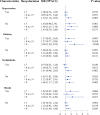Relationship of sleep duration with incident cardiovascular outcomes: a prospective study of 33,883 adults in a general population
- PMID: 36653782
- PMCID: PMC9847128
- DOI: 10.1186/s12889-023-15042-x
Relationship of sleep duration with incident cardiovascular outcomes: a prospective study of 33,883 adults in a general population
Abstract
Background: Studies on the effect of sleep duration on cardiovascular health have contradictory findings. Underlying health issues may have led to inconsistent results and warrant consideration. We aim to assess the relationship of night sleep duration with incident cardiovascular disease (CVD) in a general population, taking into consideration underlying chronic diseases.
Methods: Data from Shanghai Suburban Adult Cohort and Biobank with a median follow-up of 5.1 years was used, including 33,883 adults aged 20-74 years old. Incident CVD cases were reported and recorded by the Center for Disease Prevention and Control in Songjiang, Shanghai. We used Cox proportional hazard regression models and restricted cubic spline (RCS) analysis to explore the relationship between different sleep groups and sleep duration with incident CVD outcomes, through stratification by gender and age, as well as different health conditions, with adjustments for potential confounders.
Results: Long sleep duration (> 9 h) compared to > 7 to ≤ 8 h was associated with overall incident CVD in participants aged ≥ 50 years old: HR(95%CI) = 2.07 (1.15, 3.74) for 50-59y and 1.43 (1.04, 1.93) for 60-74y. RCS analysis showed a J-shaped relationship between sleep and CVD risk in those ≥ 50y, which was confirmed only in those with a chronic health condition. Non-linear relationships between sleep and CVD risk factors, such as BMI, blood glucose and glycated haemoglobin, were observed.
Conclusions: Long sleep duration is associated with increased risk of CVD in people ≥ 50y. However, CVD risk factors and underlying health conditions such as hypertension, and diabetes, may play a driving role in the relationship.
Keywords: Cardiovascular disease; Cohort studies; Epidemiology; Sleep duration.
© 2023. The Author(s).
Conflict of interest statement
The authors declare that they have no competing interests.
Figures



References
-
- WHO . Global Status Report on Noncommunicable Diseases. Geneva, Switzerland: World Health Organization; 2014.
Publication types
MeSH terms
Grants and funding
LinkOut - more resources
Full Text Sources

